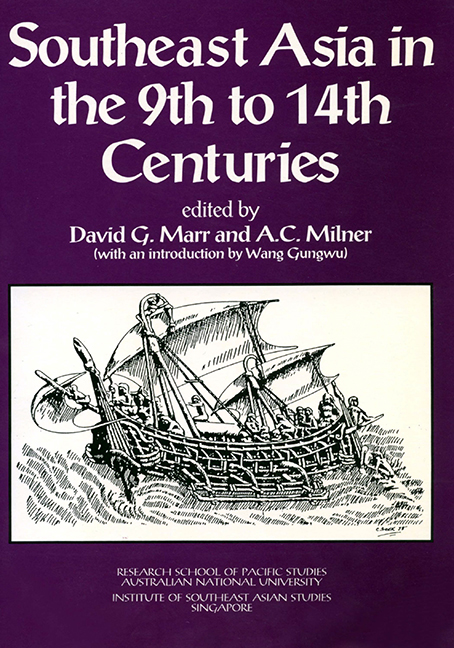Book contents
- Frontmatter
- Contents
- Contributors
- Preface
- Introduction
- 1 The Early and the Imperial Kingdom in Southeast Asian History
- 2 Hydraulic Works and South East Asian Polities
- 3 Some Notes on Relations between Central and Local Government in Ancient Java
- 4 Negara, Mandala, and Despotic State: Images of Early Java
- 5 Some Remarks on Early State Formation in Cambodia
- 6 “Elephants Can Actually Swim”: Contemporary Chinese Views of Late Ly Dai Viet
- 7 Authority and Legitimacy in 11th Century Vietnam
- 8 From Myth to History: Imagined Polities in 14th Century Vietnam
- 9 Shipshape Societies: Boat Symbolism and Political Systems in Insular Southeast Asia
- 10 Changing Perspectives in Island Southeast Asia
- 11 Political and Cultural Continuities at Dvaravati Sites
- 12 The True and the Corbel Arch in Mainland Southeast Asian Monumental Architecture
- 13 Vietnamese Ceramics and Cultural Identity: Evidence from the Ly and Tran Dynasties
- 14 Traditions, Acculturation, Renovation: The Evolutional Pattern of Vietnamese Culture
- 15 Symbolism of Kingship in Arakan
- 16 Buddhism in Champa
- 17 The Ordering of Generations: Change and Continuity in Old Javanese Kinship
- 18 Sources on Economic Activities in Khmer and Cham Lands
- 19 Narrative Bas-Reliefs at Candi Surawana
- 20 Possibilities for a Reading of the 1293-1357 Period in the Vietnamese Annals
- Index
- Miscellaneous Endmatter
17 - The Ordering of Generations: Change and Continuity in Old Javanese Kinship
Published online by Cambridge University Press: 21 October 2015
- Frontmatter
- Contents
- Contributors
- Preface
- Introduction
- 1 The Early and the Imperial Kingdom in Southeast Asian History
- 2 Hydraulic Works and South East Asian Polities
- 3 Some Notes on Relations between Central and Local Government in Ancient Java
- 4 Negara, Mandala, and Despotic State: Images of Early Java
- 5 Some Remarks on Early State Formation in Cambodia
- 6 “Elephants Can Actually Swim”: Contemporary Chinese Views of Late Ly Dai Viet
- 7 Authority and Legitimacy in 11th Century Vietnam
- 8 From Myth to History: Imagined Polities in 14th Century Vietnam
- 9 Shipshape Societies: Boat Symbolism and Political Systems in Insular Southeast Asia
- 10 Changing Perspectives in Island Southeast Asia
- 11 Political and Cultural Continuities at Dvaravati Sites
- 12 The True and the Corbel Arch in Mainland Southeast Asian Monumental Architecture
- 13 Vietnamese Ceramics and Cultural Identity: Evidence from the Ly and Tran Dynasties
- 14 Traditions, Acculturation, Renovation: The Evolutional Pattern of Vietnamese Culture
- 15 Symbolism of Kingship in Arakan
- 16 Buddhism in Champa
- 17 The Ordering of Generations: Change and Continuity in Old Javanese Kinship
- 18 Sources on Economic Activities in Khmer and Cham Lands
- 19 Narrative Bas-Reliefs at Candi Surawana
- 20 Possibilities for a Reading of the 1293-1357 Period in the Vietnamese Annals
- Index
- Miscellaneous Endmatter
Summary
Introduction
This brief communication is intended to offer a few simple observations on old Javanese kinship. In 1977, when I was a Fellow at the Netherlands Institute for Advanced Study in Wassenaar, I had the good fortune of spending a considerable time with the noted scholar P.J. Zoetmulder, who was then in the process of completing his massive dictionary of old Javanese. In the course of various informal discussions, the question arose of whether it was possible to construct from among the entries in his dictionary the structure of the old Javanese kinship system. The question was not simply a philological one of tracing the changes that have occurred in the Javanese words used to refer to particular categories of relatives, but rather the more anthropological question of investigating whether a coherent terminological system could be established for old Javanese relational categories as a whole, and whether it was possible to compare this configuration of relationship terms with that used by Javanese today. This exercise seemed particularly relevant to the study of Javanese history because, since the time of W.H. Rassers, there have been persistent suggestions in the published literature on Java (see Bertling 1936 as an example) that the kinship and social organization of ancient Java was markedly different from that of the present day. Therefore, with typical enthusiasm, Zoetmulder searched his entire collection of file cards and produced for me all of the entries that he could find that related to kinship. Zoetmulder's dictionary has since been published and is generally available. It is nevertheless appropriate that I acknowledge that the initial analysis on which this paper is based was undertaken with Zoetmulder's unpublished notes and thoughtful assistance.
Old Javanese and modern Javanese
Methodological difficulties abound in attempting a comparison between old Javanese and modern Javanese particularly on account of the problems involved in specifying the two targets for comparison. For his purposes Zoetmulder defines old Javanese as the language of the earliest Javanese literature which was produced on Java between the 9th and 14th centuries, and thereafter was preserved on Bali where it has continued in use to the present day.
- Type
- Chapter
- Information
- Southeast Asia in the 9th to 14th Centuries , pp. 315 - 326Publisher: ISEAS–Yusof Ishak InstitutePrint publication year: 1986

